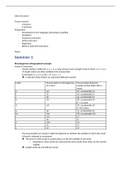Old Irish week 2
Course manual:
- 2 lectures
- 2 seminars
Preparation
- Introduction to the language, phonology & spelling
- Mutations
- Possessive pronouns
- Article and noun
- Adjectives
- Births in Early Irish Literature
Notes:
Seminar 1
Phonological & orthographical concepts
Vowel & consonant
- Vowels written in Old Irish: a, e, i, o, u, long versions have a length mark on them: ā, ē, ī, ō, ū
length marks are often omitted in the manuscripts
- Consonants: b, c, d, f, g, (h), l, m, n, p, r, s, t
In Old Irish these letters can represent different sounds!
Letter Pronunciation at the beginning Pronunciation between
of a word vowels/as final letter after a
vowel
p /p/ /b/, occasionally /p/
t /t/ /d/, occasionally /t/
c /k/ /g/, occasionally /k/
b /b/ /β/, occasionally /b/
β = v in vase
d /d/ /ð/, occasionally /d/
ð = th in then
g /g/ /ɣ/, occasionally /g/
m /m/ /v͂ /, occasionally /m/
r /rr/ /r/
l /ll/ /l/
n /nn/ /n/
f /f/ /f/
s /s/ /s/
- The pronunciation of vowels in Old Irish depends on whether the syllable in which the vowel
is found is stressed or unstressed
The stress in Irish words is usually places on the first syllable of the word
o Exceptions: some words are unstressed & some words have stress on the second
syllable
Length marks do not indicate stress!
, Letter Stressed unstressed
a /a/ /ə/
e /e/ /ə/
i /i/ /ə/
o /o/ /ə/
u /u/ /u/
Diphthongs
- Diphthongs in early Irish: aí/áe, oí/óe, ía, uí, au, áu/áo, eu, éu/éo, íu, ou, óu, úa
Hiatus
- Two vowels that stand next to each other but are not combined in pronunciation, the
pronunciation break is called hiatus
- Often indicated with diaeresis over one of the two vowels (usually the second vowel): oäc
- Mainly found in early texts
Prefixed h
- Written in front of a (short) word, usually not pronounced
Consonant color
- Also called consonant quality
- Pronunciation of a consonant in Old Irish originally depended on which vowel followed it
o If the consonant was followed by o, a, u pronounced normally (= neutral/broad
color/quality)
o o, a sometimes called neutral/broad vowels
o If the consonant was followed by i, e pronounced slightly differently (= palatal
color/quality or slender consonant)
o Vowel i: almost always both consonant following & preceding is are palatal
o Vowel e: generally consonant preceding it is palatal, consonant following it is neutral
o e, i sometimes called palatal/slender vowels
Glide vowels
- Always placed between consonant & other vowel (or vice versa), their only function is to
indicate either that the consonant that follows it is palatal or that the consonant which
precedes it is neutral or palatal
- Glide vowels are not pronounced!
- 3 glide vowels: i, e, a
o i is the only one that is found in 2 cases
It can be added to a word to indicate that the consonant following it is
palatal
It can be placed between a consonant and a final unstressed u to indicate
that the consonant before the u is palatal
It is a useful indicator of palatalization
o e and a are found between a consonant and final unstressed vowel
e is inserted between a palatal consonant & the neutral vowels o or a
a is inserted between a neutral consonant & the palatal vowels e or i
- There is a palatalized version for every consonant sound
o Written as pj/p’






